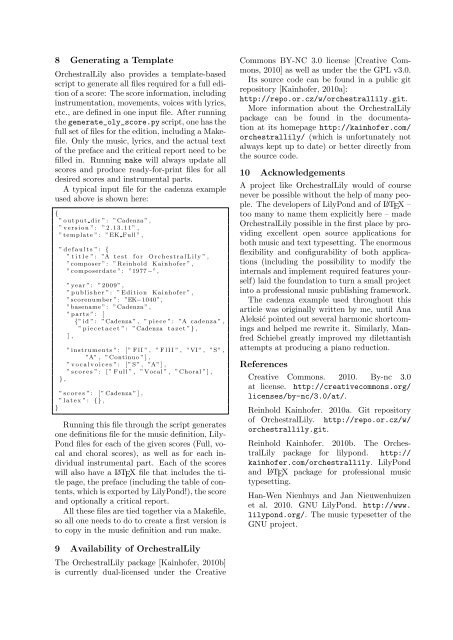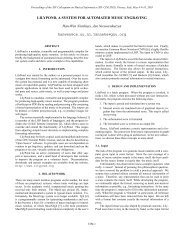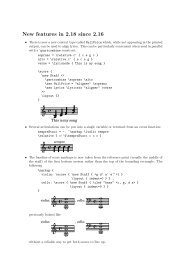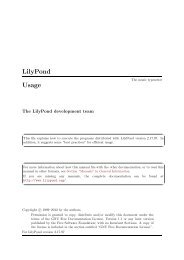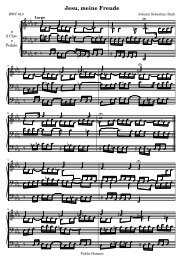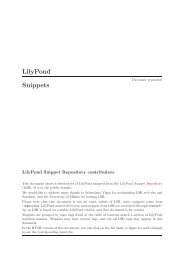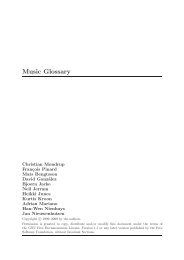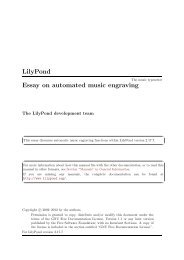OrchestralLily: A Package for Professional Music ... - LilyPond
OrchestralLily: A Package for Professional Music ... - LilyPond
OrchestralLily: A Package for Professional Music ... - LilyPond
You also want an ePaper? Increase the reach of your titles
YUMPU automatically turns print PDFs into web optimized ePapers that Google loves.
8 Generating a Template<br />
<strong>OrchestralLily</strong> also provides a template-based<br />
script to generate all files required <strong>for</strong> a full edition<br />
of a score: The score in<strong>for</strong>mation, including<br />
instrumentation, movements, voices with lyrics,<br />
etc., are defined in one input file. After running<br />
the generate_oly_score.py script, one has the<br />
full set of files <strong>for</strong> the edition, including a Makefile.<br />
Only the music, lyrics, and the actual text<br />
of the preface and the critical report need to be<br />
filled in. Running make will always update all<br />
scores and produce ready-<strong>for</strong>-print files <strong>for</strong> all<br />
desired scores and instrumental parts.<br />
A typical input file <strong>for</strong> the cadenza example<br />
used above is shown here:<br />
{<br />
” o u t p u t d i r ” : ”Cadenza ” ,<br />
” v e r s i o n ” : ” 2 . 1 3 . 1 1 ” ,<br />
” template ” : ” EK Full ” ,<br />
” d e f a u l t s ” : {<br />
” t i t l e ” : ”A t e s t f o r O r c h e s t r a l L i l y ” ,<br />
” composer ” : ” Reinhold Kainhofer ” ,<br />
” composerdate ” : ”1977 −” ,<br />
” year ” : ”2009” ,<br />
” p u b l i s h e r ” : ” E d i t i o n Kainhofer ” ,<br />
” scorenumber ” : ”EK−1040” ,<br />
”basename ” : ”Cadenza ” ,<br />
” p a r t s ” : [<br />
{” i d ” : ”Cadenza ” , ” p i e c e ” : ”A cadenza ” ,<br />
” p i e c e t a c e t ” : ”Cadenza t a z e t ”} ,<br />
] ,<br />
” i n s t r u m e n t s ” : [ ” F l I ” , ” F l I I ” , ”VI ” , ”S ” ,<br />
”A” , ” Continuo ” ] ,<br />
” v o c a l v o i c e s ” : [ ” S ” , ”A” ] ,<br />
” s c o r e s ” : [ ” F u l l ” , ” Vocal ” , ” Choral ” ] ,<br />
} ,<br />
” s c o r e s ” : [ ” Cadenza ” ] ,<br />
” l a t e x ” : {} ,<br />
}<br />
Running this file through the script generates<br />
one definitions file <strong>for</strong> the music definition, Lily-<br />
Pond files <strong>for</strong> each of the given scores (Full, vocal<br />
and choral scores), as well as <strong>for</strong> each individual<br />
instrumental part. Each of the scores<br />
will also have a L A TEX file that includes the title<br />
page, the preface (including the table of contents,<br />
which is exported by <strong>LilyPond</strong>!), the score<br />
and optionally a critical report.<br />
All these files are tied together via a Makefile,<br />
so all one needs to do to create a first version is<br />
to copy in the music definition and run make.<br />
Commons BY-NC 3.0 license [Creative Commons,<br />
2010] as well as under the the GPL v3.0.<br />
Its source code can be found in a public git<br />
repository [Kainhofer, 2010a]:<br />
http://repo.or.cz/w/orchestrallily.git.<br />
More in<strong>for</strong>mation about the <strong>OrchestralLily</strong><br />
package can be found in the documentation<br />
at its homepage http://kainhofer.com/<br />
orchestrallily/ (which is un<strong>for</strong>tunately not<br />
always kept up to date) or better directly from<br />
the source code.<br />
10 Acknowledgements<br />
A project like <strong>OrchestralLily</strong> would of course<br />
never be possible without the help of many people.<br />
The developers of <strong>LilyPond</strong> and of L A TEX –<br />
too many to name them explicitly here – made<br />
<strong>OrchestralLily</strong> possible in the first place by providing<br />
excellent open source applications <strong>for</strong><br />
both music and text typesetting. The enormous<br />
flexibility and configurability of both applications<br />
(including the possibility to modify the<br />
internals and implement required features yourself)<br />
laid the foundation to turn a small project<br />
into a professional music publishing framework.<br />
The cadenza example used throughout this<br />
article was originally written by me, until Ana<br />
Aleksić pointed out several harmonic shortcomings<br />
and helped me rewrite it. Similarly, Manfred<br />
Schiebel greatly improved my dilettantish<br />
attempts at producing a piano reduction.<br />
References<br />
Creative Commons. 2010. By-nc 3.0<br />
at license. http://creativecommons.org/<br />
licenses/by-nc/3.0/at/.<br />
Reinhold Kainhofer. 2010a. Git repository<br />
of <strong>OrchestralLily</strong>. http://repo.or.cz/w/<br />
orchestrallily.git.<br />
Reinhold Kainhofer. 2010b. The <strong>OrchestralLily</strong><br />
package <strong>for</strong> lilypond. http://<br />
kainhofer.com/orchestrallily. <strong>LilyPond</strong><br />
and L A TEX package <strong>for</strong> professional music<br />
typesetting.<br />
Han-Wen Nienhuys and Jan Nieuwenhuizen<br />
et al. 2010. GNU <strong>LilyPond</strong>. http://www.<br />
lilypond.org/. The music typesetter of the<br />
GNU project.<br />
9 Availability of <strong>OrchestralLily</strong><br />
The <strong>OrchestralLily</strong> package [Kainhofer, 2010b]<br />
is currently dual-licensed under the Creative


